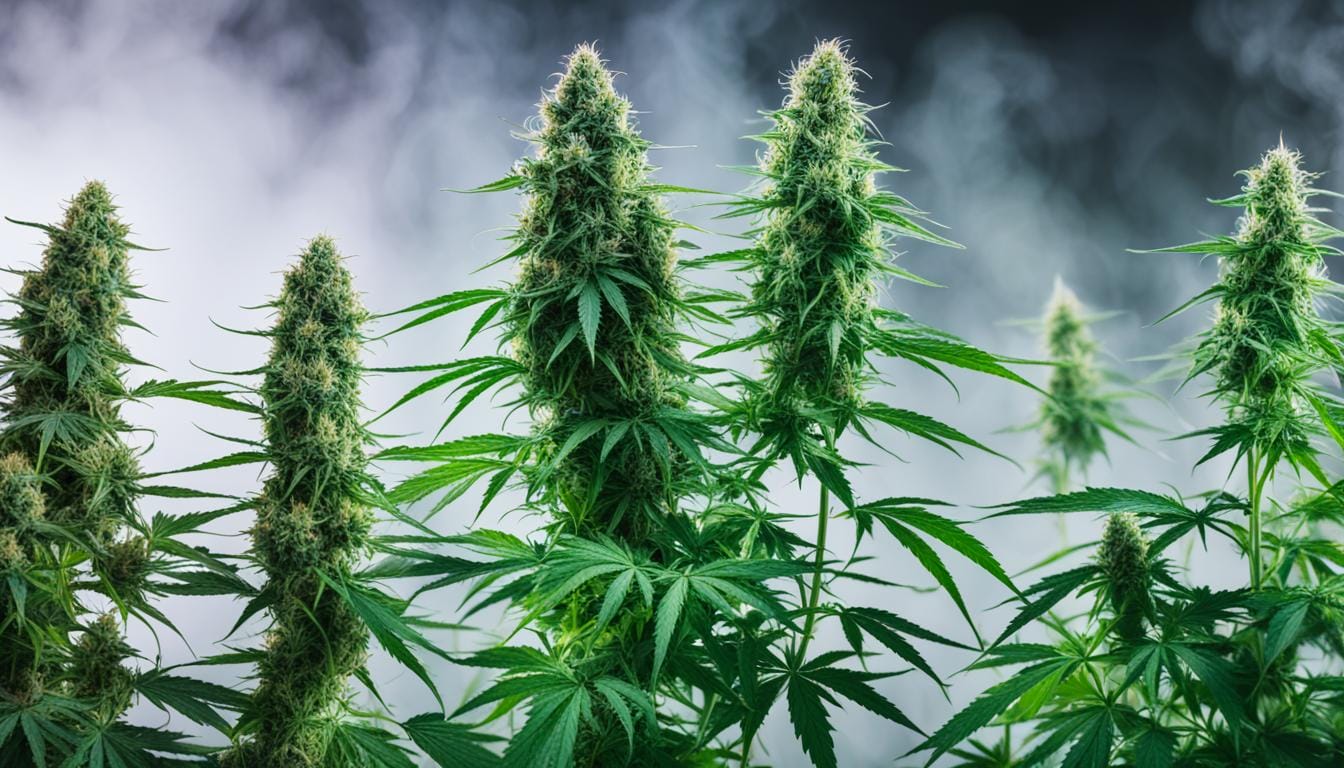Introduction to AI in Agriculture The integration of Artificial Intelligence (AI) into agriculture is no longer a futuristic concept but a transformative reality. In the realm of agriculture, AI’s potential to optimize processes, maximize yields, and sustain environmental resources is unparalleled. This is especially pertinent in specialized sectors such as cannabis cultivation, where precision and […]
Understanding Cannabis Hyperemesis Syndrome: Facts & Insights

Cannabis Hyperemesis Syndrome (CHS) is a condition characterized by cyclical vomiting, abdominal pain, and nausea in individuals who use cannabis regularly. While the exact cause of CHS is not fully understood, research has shown a link between heavy, prolonged cannabis use and the development of this syndrome. In this article, we will explore the facts and insights surrounding CHS, shedding light on this uncommon condition.
Key Takeaways
- Cannabis Hyperemesis Syndrome is a condition characterized by cyclical vomiting, abdominal pain, and nausea in heavy, prolonged cannabis users
- Prolonged cannabis use is a significant risk factor for CHS, but not everyone who uses cannabis heavily will experience CHS
- CHS symptoms occur in phases, the first phase is the prodromal phase, the second phase is the hyperemetic phase, and the final phase is the recovery phase
- The primary treatment for CHS involves discontinuing cannabis use, often leading to a significant improvement in symptoms
- Preventing CHS largely relies on educating individuals about the potential risks of heavy, prolonged cannabis use and seeking medical attention for persistent symptoms
The Rise in Cannabis Hyperemesis Syndrome Cases
Cannabis Hyperemesis Syndrome is relatively rare but has been increasingly recognized by medical professionals in recent years. It was first described in the medical literature in 2004, and since then, there have been numerous documented cases. People who use cannabis daily or near-daily for extended periods, typically several years, are at a higher risk of developing CHS. However, it is important to note that not everyone who uses cannabis heavily will experience CHS.
Recognizing the symptoms of CHS is essential for accurate diagnosis and treatment. The primary symptoms of CHS include chronic cannabis use, cyclic vomiting, nausea, and abdominal pain. The vomiting and nausea often occur in episodes and can last for several days. Individuals may also experience weight loss, dehydration, and sleep disturbances.
Diagnosis and Treatment Overview
Diagnosing CHS can be challenging because its symptoms can resemble other gastrointestinal conditions. Medical professionals typically diagnose CHS by ruling out other possible causes of the symptoms and considering the individual’s history of heavy cannabis use. Blood tests and imaging studies may also be conducted to help rule out other potential causes. It is crucial for healthcare providers to have a high index of suspicion for CHS in patients with a history of heavy cannabis use and recurrent vomiting.
The primary treatment for CHS involves discontinuing cannabis use, which often leads to a significant improvement in symptoms. Other measures, such as intravenous fluids to correct dehydration and medications to control nausea and vomiting, may be necessary during acute episodes. Topical capsaicin cream, which contains an active component found in chili peppers, has also shown promise in providing relief from CHS symptoms. However, further research is needed to determine its efficacy and safety.
Preventing CHS largely relies on educating individuals about the potential risks of heavy, prolonged cannabis use. Moderation and responsible use are key to minimizing the chances of developing this syndrome. Understanding one’s tolerance, taking breaks from cannabis use, and seeking medical attention for persistent symptoms are all important steps in preventing CHS from occurring or worsening.
Understanding CHS Symptoms
The symptoms of Cannabis Hyperemesis Syndrome (CHS) usually occur in phases. The first phase is the prodromal phase, which includes weight loss, morning nausea, and abdominal discomfort. This phase can last for months or years, and individuals may not suspect that their symptoms are related to cannabis use.
The second phase is the hyperemetic phase, characterized by recurrent episodes of intense nausea, vomiting, and abdominal pain. These episodes can last for hours to several days and often require medical intervention for relief. The final phase is the recovery phase, where individuals experience relief from symptoms after ceasing cannabis use.
CHS is often misdiagnosed as cyclic vomiting syndrome due to their similarities in symptoms. However, CHS is specifically linked to chronic cannabis abuse and can be differentiated by taking a detailed history of cannabis use.
It is important to note that not everyone who uses cannabis heavily will experience CHS, but those who do should seek medical attention promptly to avoid long-term complications.
The Peculiar Symptom Relief
One peculiar aspect of Cannabis Hyperemesis Syndrome (CHS) is that hot water bathing or showering may alleviate symptoms temporarily. This distinctive symptom relief has led to the term “hot water bathing syndrome” being used interchangeably with CHS. The reason behind the effectiveness of hot water baths remains unclear, but it is believed to have a temporary inhibitory effect on the cannabinoid receptors involved in CHS.
During a CHS attack, individuals experience severe nausea and vomiting, often leading to dehydration. Traditional antiemetic medications may not be effective in providing relief. However, immersion in hot water, such as taking a hot shower or bath, can provide temporary relief from CHS symptoms. The use of hot water in CHS has been documented in medical literature, and many patients report finding relief through this method.
The mechanism behind hot water’s efficacy in CHS is not fully understood, but it is thought to be related to the activation of the transient receptor potential vanilloid 1 (TRPV1) receptors. These receptors are activated by heat and capsaicin, the component in chili peppers that gives them their heat. It is believed that hot water bathing activates these receptors, leading to the release of neuropeptides that inhibit the cannabinoid receptors involved in CHS.
Other Relief Options
While the relief provided by hot water can be significant, it is important to note that it is temporary and does not treat the underlying cause of CHS. Discontinuing cannabis use remains the primary treatment for CHS, as it often leads to a significant improvement in symptoms. However, hot water bathing can provide symptomatic relief during acute episodes, and patients should be advised to use this method as needed.
Another potential method of relief is the use of topical capsaicin cream. This cream contains an active component found in chili peppers, which is thought to work in a similar way to hot water. It has shown promise in providing relief from CHS symptoms, particularly for patients who are unable to tolerate hot water therapy or who do not have access to it. Further research is needed to determine the efficacy and safety of this treatment option.

The Mechanism and Causes of CHS
The exact mechanism behind Cannabis Hyperemesis Syndrome is not fully understood, but several theories have been proposed. One theory is that chronic, heavy cannabis use dysregulates the endocannabinoid system, resulting in abnormal gastrointestinal motility and increased sensitivity to pain. Another theory suggests that certain compounds in cannabis, such as cannabidiol (CBD) and delta-9-tetrahydrocannabinol (THC), could contribute to the development of CHS. It is also possible that both of these factors play a role in the development of CHS.
In addition to the above theories, excessive marijuana use has also been linked to nausea and vomiting, which could contribute to the development of CHS. Research into the causes of CHS is ongoing, and more information is needed to fully understand this condition.
Despite the lack of a clear understanding of the underlying causes, efforts are being made to better understand CHS. In recent years, there has been an increase in CHS research, which has led to better awareness of this condition and improved treatment options for those who suffer from it.
Diagnosing CHS
Diagnosing Cannabis Hyperemesis Syndrome can be challenging because its symptoms can resemble other gastrointestinal conditions. Medical professionals typically diagnose CHS by ruling out other possible causes of the symptoms and considering the individual’s history of heavy cannabis use.
Blood tests and imaging studies may also be conducted to help rule out other potential causes. It is crucial for healthcare providers to have a high index of suspicion for CHS in patients with a history of heavy cannabis use and recurrent vomiting.
Treatment Options for CHS
The primary treatment for Cannabis Hyperemesis Syndrome involves discontinuing cannabis use, which often leads to a significant improvement in symptoms. Individuals who experience recurrent episodes of vomiting and nausea may require medical intervention to manage their symptoms. Intravenous fluids can help correct dehydration, and medications such as ondansetron can help control nausea and vomiting.
Additionally, topical capsaicin cream has shown promise in providing relief from CHS symptoms. Capsaicin is an active component found in chili peppers that has been used to relieve pain and inflammation. Although there is limited research on the efficacy and safety of capsaicin cream for CHS, some studies have demonstrated its potential benefits in managing symptoms. It is believed that capsaicin works by desensitizing the TRPV1 receptors in the gut, which are also involved in the regulation of pain and inflammation.
While there is no cure for CHS, discontinuing cannabis use and managing symptoms can help individuals improve their quality of life. Healthcare providers may recommend other treatments, such as cognitive-behavioral therapy or support groups, to help individuals manage their cannabis use and prevent relapse.
Other Treatment Options for CHS
Other treatment options for CHS may include:
- Antiemetic medications, such as promethazine or metoclopramide, which can help control nausea and vomiting
- Fluid and electrolyte replacement therapy to correct dehydration
- Nutritional support to address weight loss and malnutrition
- Psychological support to address underlying mental health concerns or addiction issues
It is important for individuals with CHS to work closely with their healthcare providers to develop a comprehensive treatment plan that addresses their individual needs and concerns.
The Peculiar Symptom Relief
Topical capsaicin cream, which contains an active component found in chili peppers, has also shown promise in providing relief from Cannabis Hyperemesis Syndrome symptoms. Capsaicin is a compound that has analgesic (pain-relieving) and anti-inflammatory properties. It works by desensitizing the nerve fibers that transmit pain signals to the brain, reducing the sensation of pain and discomfort caused by CHS.
While the use of capsaicin cream for CHS is still experimental, some studies have shown positive results. One study found that the application of capsaicin cream to the abdomen of CHS patients provided rapid relief from nausea and vomiting. Another study reported that daily application of capsaicin cream to the skin for a week resulted in a significant reduction in CHS symptoms.
It is important to note that capsaicin cream may not be suitable for everyone, and it can cause skin irritation and burning sensations in some individuals. Medical supervision is recommended when using capsaicin cream for CHS relief.

Preventing CHS
Preventing Cannabis Hyperemesis Syndrome largely relies on educating individuals about the potential risks of heavy, prolonged cannabis use. Responsible cannabis use involves understanding one’s tolerance, taking breaks from cannabis use, and seeking medical attention for persistent symptoms. Consider reducing the frequency of cannabis use and avoid using it daily or near-daily for extended periods, typically several years. Individuals who experience symptoms such as nausea, vomiting, and abdominal pain should seek medical attention promptly to rule out CHS or other potential medical conditions.
It’s also important to avoid using unregulated or contaminated cannabis products. Certain additives, such as vitamin E acetate, have been linked to the development of pulmonary illnesses and could potentially contribute to CHS development.
Finally, if you’re considering using cannabis for medicinal or recreational purposes, it’s essential to talk to a healthcare provider about the potential risks and benefits. They can help you make an informed decision about whether cannabis use is appropriate for your individual needs and circumstances.

Understanding Cannabis Hyperemesis Syndrome: Conclusion
Cannabis Hyperemesis Syndrome is a condition characterized by cyclical vomiting, abdominal pain, and nausea in heavy, prolonged cannabis users. While the exact cause of CHS remains unclear, prolonged cannabis use is a significant risk factor. Recognizing the symptoms and seeking medical attention for accurate diagnosis and treatment is crucial. The primary treatment involves discontinuing cannabis use, which often leads to symptom improvement. Other treatments, such as intravenous fluids and topical capsaicin cream, may also be effective in managing CHS symptoms.
Preventing CHS largely relies on educating individuals about the potential risks of heavy, prolonged cannabis use. Moderation and responsible use are key to minimizing the chances of developing this syndrome. Understanding one’s tolerance, taking breaks from cannabis use, and seeking medical attention for persistent symptoms are all important steps in preventing CHS from occurring or worsening.
By understanding the facts and insights surrounding CHS, individuals can make informed decisions about their cannabis use and mitigate the risks associated with this lesser-known syndrome. It is crucial for healthcare providers to have a high index of suspicion for CHS in patients with a history of heavy cannabis use and recurrent vomiting. With the proper diagnosis and management, individuals with Cannabis Hyperemesis Syndrome can achieve relief from their symptoms and improve their quality of life.
Now that you know all about Cannabis Hyperemesis Syndrome, shop the collection of regular, feminized, and autoflower cannabis seeds at Seeds Here Now.
FAQ
Q: What is Cannabis Hyperemesis Syndrome (CHS)?
A: Cannabis Hyperemesis Syndrome is a condition characterized by cyclical vomiting, abdominal pain, and nausea in individuals who use cannabis regularly.
Q: Who is at risk of developing CHS?
A: People who use cannabis daily or near-daily for extended periods, typically several years, are at a higher risk of developing CHS.
Q: What are the symptoms of Cannabis Hyperemesis Syndrome?
A: The symptoms of Cannabis Hyperemesis Syndrome include weight loss, morning nausea, abdominal discomfort, recurrent episodes of intense nausea, vomiting, and abdominal pain.
Q: What is “hot water bathing syndrome”?
A: “Hot water bathing syndrome” is a term used interchangeably with CHS due to the temporary relief of symptoms experienced by CHS patients when taking hot baths or showers.
Q: What causes CHS?
A: The exact cause of Cannabis Hyperemesis Syndrome is not fully understood, but it is believed that chronic cannabis use dysregulates the endocannabinoid system, resulting in abnormal gastrointestinal motility and increased sensitivity to pain.
Q: How is Cannabis Hyperemesis Syndrome diagnosed?
A: CHS is typically diagnosed by ruling out other possible causes of the symptoms and considering the individual’s history of heavy cannabis use. Blood tests and imaging studies may also be conducted to help with the diagnosis.
Q: What is the primary treatment for CHS?
A: The primary treatment for Cannabis Hyperemesis Syndrome involves discontinuing cannabis use, which often leads to a significant improvement in symptoms. Intravenous fluids and medications to control nausea and vomiting may be necessary during acute episodes.
Q: Can topical cream provide relief from CHS symptoms?
A: Topical capsaicin cream, containing an active component found in chili peppers, has shown promise in providing relief from CHS symptoms, but further research is needed to determine its efficacy and safety.
Q: How can Cannabis Hyperemesis Syndrome be prevented?
A: CHS can be prevented by educating individuals about the potential risks of heavy, prolonged cannabis use, practicing moderation and responsible use, taking breaks from cannabis use, and seeking medical attention for persistent symptoms.
Q: What is the importance of understanding and addressing CHS?
A: Understanding and addressing CHS is crucial for the well-being of heavy cannabis users as it can help prevent the development or worsening of this syndrome and promote overall health and wellness.
Back





